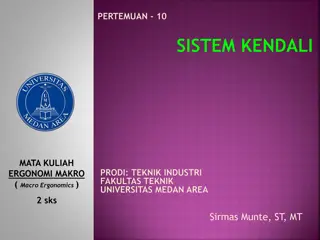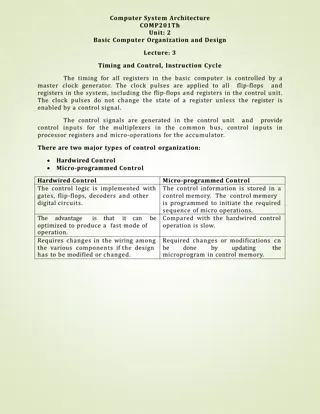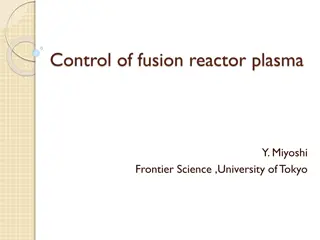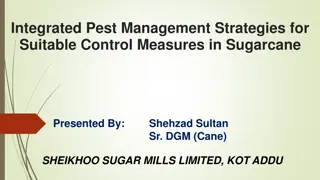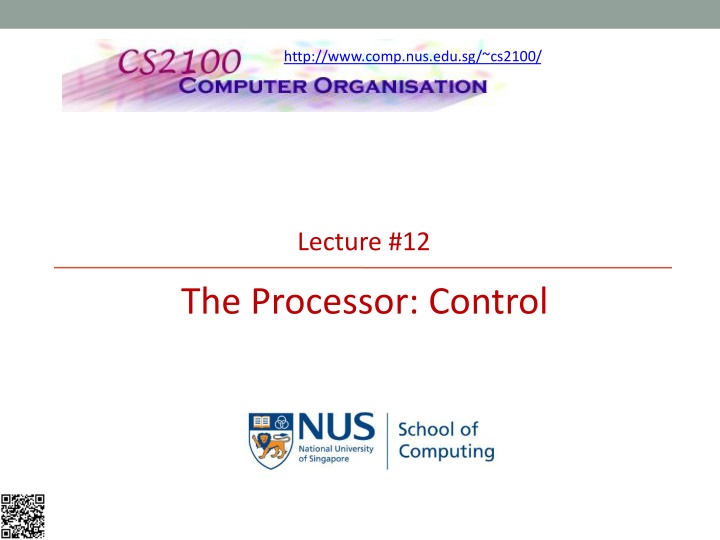
Processor Control Signals and Datapath Implementation
Explore the intricacies of processor control signals and the implementation of datapaths in lecture #12, presented by Aaron Tan from NUS. Learn about generating control signals based on instructions, identified control signals, and the essential components of a control unit.
Download Presentation

Please find below an Image/Link to download the presentation.
The content on the website is provided AS IS for your information and personal use only. It may not be sold, licensed, or shared on other websites without obtaining consent from the author. If you encounter any issues during the download, it is possible that the publisher has removed the file from their server.
You are allowed to download the files provided on this website for personal or commercial use, subject to the condition that they are used lawfully. All files are the property of their respective owners.
The content on the website is provided AS IS for your information and personal use only. It may not be sold, licensed, or shared on other websites without obtaining consent from the author.
E N D
Presentation Transcript
http://www.comp.nus.edu.sg/~cs2100/ Lecture #12 The Processor: Control
Questions? Ask at https://sets.netlify.app/module/676ca3a07d7f5ffc1741dc65 OR Scan and ask your questions here! (May be obscured in some slides)
Aaron Tan, NUS Lecture #12: The Processor: Control 3 Lecture #12: Processor: Control 1. Identified Control Signals 2. Generating Control Signals: Idea 3. The Control Unit 4. Control Signals 5. ALU Control Signal 6. Instruction Execution
4 Complete Datapath Aaron Tan, NUS Lecture #12: The Processor: Control Instruction Memory Add PC M U X 4 Instruction Add Left Shift 2-bit Address PCSrc opcode 000000 31:26 ALUcontrol 4 25:21 01001 Inst [25:21] 5 rs RR1 RD1 5 MemWrite is0? RR2 20:16 01010 rt Register File ALU ALUSrc 5 WR ALU result M U X Address 15:11 01000 M U X RD2 rd Data Memory MemToReg WD Inst [15:11] Read Data shamt 00000 RegWrite M U X 10:6 RegDst Write Data Sign Extend Inst [15:0] 100000 funct 5:0 MemRead
Aaron Tan, NUS Lecture #12: The Processor: Control 5 1. Identified Control Signals Control Signal Execution Stage Purpose Select the destination register number RegDst Decode/Operand Fetch Decode/Operand Fetch RegWrite RegWrite Enable writing of register ALUSrc ALU Select the 2nd operand for ALU Select the operation to be performed ALUcontrol ALU MemRead / MemWrite Enable reading/writing of data memory Memory Select the result to be written back to register file MemToReg RegWrite PCSrc Memory/RegWrite Select the next PC value
Aaron Tan, NUS Lecture #12: The Processor: Control 6 2. Generating Control Signals: Idea The control signals are generated based on the instruction to be executed: Opcode Instruction Format Example: R-Format instruction RegDst = 1 (use Inst[15:11]) ) R-Type instruction has additional information: The 6-bit "funct" (function code, Inst[5:0]) field Idea: Design a combinational circuit to generate these signals based on Opcode and possibly Function code A control unit is needed (a draft design is shown next)
7 The Control Unit (draft) Aaron Tan, NUS Lecture #12: The Processor: Control Instruction Memory Add PC M U X 4 Instruction Add Left Shift 2-bit Control Address PCSrc opcode 000000 31:26 ALUcontrol 4 25:21 01001 Inst [25:21] 5 rs RR1 RD1 5 MemWrite is0? RR2 20:16 01010 rt Register File ALU ALUSrc 5 WR ALU result M U X Address 15:11 01000 M U X RD2 rd Data Memory MemToReg WD Inst [15:11] Read Data shamt 00000 RegWrite M U X 10:6 RegDst Write Data Sign Extend Inst [15:0] 100000 funct 5:0 MemRead
Aaron Tan, NUS Lecture #12: The Processor: Control 8 3. Let s Implement the Control Unit! Approach: Take note of the instruction subset to be implemented: Opcode and Function Code (if applicable) Go through each signal: Observe how the signal is generated based on the instruction opcode and/or function code Construct truth table Design the control unit using logic gates
Aaron Tan, NUS Lecture #12: The Processor: Control 9 3. MIPS Instruction Subset (Review) opcode 31 shamt funct 25 20 15 10 5 rs rt rd 0 016 016 016 016 016 2016 2216 2416 2516 2A16 add rs rs rs rt rt rt rd rd rd 0 0 0 sub R-type and or rs rt rd 0 slt 31 25 20 15 rs rs rd rd offset offset 2316 2B16 lw sw I-type rs rd offset 416 beq
Aaron Tan, NUS Lecture #12: The Processor: Control 10 4. Control Signal: RegDst False (0): Write register = Inst[20:16] True (1): Write register = Inst[15:11] 0 M U X 1 Signal
Aaron Tan, NUS Lecture #12: The Processor: Control 11 4. Control Signal: RegWrite False (0): No register write True (1): New value will be written
Aaron Tan, NUS Lecture #12: The Processor: Control 12 4. Control Signal: ALUSrc False (0): Operand2 = Register Read Data 2 True (1): Operand2= SignExt(Inst[15:0])
Aaron Tan, NUS Lecture #12: The Processor: Control 13 4. Control Signal: MemRead False (0): Not performing memory read access True (1): Read memory using Address
Aaron Tan, NUS Lecture #12: The Processor: Control 14 4. Control Signal: MemWrite False (0): Not performing memory write operation True (1): memory[Address] Register Read Data 2
Aaron Tan, NUS Lecture #12: The Processor: Control 15 4. Control Signal: MemToReg True (1): Register write data = Memory read data False (0): Register write data = ALU result 1 M U X 0 Signal IMPORTANT: The input of MUX is swapped in this case
Aaron Tan, NUS Lecture #12: The Processor: Control 16 4. Control Signal: PCSrc (1/2) The "isZero?" signal from the ALU gives us the actual branch outcome (taken/not taken) Idea: If instruction is a branch ANDtaken, then
Aaron Tan, NUS Lecture #12: The Processor: Control 17 4. Control Signal: PCSrc (2/2) False (0): Next PC = PC + 4 True (1): Next PC = SignExt(Inst[15:0]) << 2 + (PC + 4) PCSrc = ( Branch AND isZero)
Aaron Tan, NUS Lecture #12: The Processor: Control 18 4. Midpoint Check Control Signal Execution Stage Purpose We have gone through almost all of the signals: Left with the more challenging ALUcontrol signal Select the destination register number Decode/Operand Fetch RegDst Decode/Operand Fetch RegWrite Enable writing of register RegWrite ALU Select the 2nd operand for ALU ALUSrc Select the operation to be performed ALU ALUcontrol MemRead / MemWrite Enable reading/writing of data memory Memory Select the result to be written back to register file RegWrite MemToReg Memory/RegWrite Select the next PC value PCSrc Observation so far: The signals discussed so far can be generated by opcode directly Function code is not needed up to this point A major part of the controller can be built based on opcode alone
The Control Unit v0.5 Aaron Tan, NUS Lecture #12: The Processor: Control 19 Instruction Memory Add M U X PC 4 Instruction Add Left Shift 2-bit Control Address PCSrc Branch opcode 31:26 Inst [31:26] 25:21 Inst [25:21] 5 rs RR1 RD1 5 is0? MemWrite RR2 20:16 rt Registers ALU ALUSrc 5 WR ALU result M U X Address 15:11 M U X RD2 rd Data Memory MemToReg WD Inst [15:11] 4 Read Data ALUcontrol shamt RegWrite M U X 10:6 RegDst Write Data Sign Extend Inst [15:0] funct 5:0 MemRead
Aaron Tan, NUS Lecture #12: The Processor: Control 20 5. Closer Look at ALU Note: We will cover combinational circuits after the recess. The ALU is a combinational circuit: Capable of performing several arithmetic operations In Lecture #11: We noted the required operations for the MIPS subset ALUcontrol 0000 0001 0010 0110 0111 1100 Function AND Question: How is the ALUcontrol signal designed? OR add subtract slt NOR
Aaron Tan, NUS Lecture #12: The Processor: Control 21 Note: We will revisit this when we cover combinational circuits later. 5. One Bit At A Time A simplified 1-bit MIPS ALU can be implemented as follows: 4 control bits are needed: Ainvert: 1 to invert input A Binvert: 1 to invert input B Operation (2-bit) To select one of the 3 results Acknowledgement: Image taken from NYU Course CSCI-UA.0436
Aaron Tan, NUS Lecture #12: The Processor: Control 22 5. One Bit At A Time (Aha!) Can you see how the ALUcontrol (4-bit) signal controls the ALU? Note: implementation for slt not shown ALUcontrol Function Ainvert Binvert Operation 0 0 00 AND 0 0 01 OR 0 0 10 add 0 1 10 subtract 0 1 11 slt 1 1 00 NOR Acknowledgement: Image taken from NYU Course CSCI-UA.0436
Aaron Tan, NUS Lecture #12: The Processor: Control 23 5. Multilevel Decoding Now we can start to design for ALUcontrol signal, which depends on: Opcode (6-bit) field and Function Code (6-bit) field Brute Force approach: Use Opcode and Function Code directly, i.e. finding expressions with 12 variables Multilevel Decoding approach: Use some of the input to reduce the cases, then generate the full output Simplify the design process, reduce the size of the main controller, potentially speedup the circuit
Aaron Tan, NUS Lecture #12: The Processor: Control 24 5. Intermediate Signal: ALUop Basic Idea: 1. Use Opcode to generate a 2-bit ALUop signal Represents classification of the instructions: Instruction type lw / sw ALUop 00 01 10 beq R-type 2. Use ALUop signal and Function Code field (for R-type instructions) to generate the 4-bit ALUcontrol signal
Aaron Tan, NUS Lecture #12: The Processor: Control 25 5. Two-level Implementation Step 1. Generate 2-bit ALUop signal from 6-bit opcode. Control opcode 6 31:26 25:21 rs Step 2. Generate ALUcontrol signal from ALUop and optionally 6-bit Funct field. ALUop 2 20:16 rt 00: lw, sw 01: beq 10: add, sub, and, or, slt ALU 15:11 rd 4 shamt ALUcontrol 10:6 0000: and 0001: or 0010: add 0110: sub 0111: set on less than ALU Control funct 6 5:0
Lecture #12: The Processor: Control 26 5. Generating ALUcontrol Signal Instruction Operation Funct field xxxxxx xxxxxx ALU action ALU control 0010 0010 Instruction Type lw / sw Opcode ALUop ALUop 00 01 10 00 00 load word add lw beq store word add sw xxxxxx 10 0000 0110 0010 01 10 branch equal subtract R-type beq add add R-type subtract subtract R-type 10 0010 10 0100 0110 0000 10 10 AND AND R-type ALUcontrol Function AND 0000 10 0101 0001 OR OR R-type 10 OR 0001 set on less than set on less than R-type 10 1010 0111 10 add 0010 subtract 0110 Generation of 2-bit ALUop signal will be discussed later slt 0111 NOR 1100
Lecture #12: The Processor: Control 27 5. Design of ALU Control Unit (1/2) Input: 6-bit Funct field and 2-bit ALUop Output: 4-bit ALUcontrol Find the simplified expressions ALUcontrol3 = 0 ALUcontrol2 = ? ALUop0 + ALUop1 F1 Funct Field ( F[5:0] == Inst[5:0] ) ALUop ALU control F5 MSB LSB F4 F3 F2 F1 F0 0 0 0 1 1 1 1 1 0 0 1 0 0 0 0 0 X X X 1 1 1 1 1 X X X 0 0 0 0 0 X X X 0 0 0 0 1 X X X 0 0 1 1 0 X X X 0 1 0 0 1 X X X 0 0 0 1 0 0 0 1 0 0 0 1 0 0 1 1 0 0 0 1 0 0 1 1 0 0 0 0 0 0 0 0 1 0 1 1 1 lw sw X beq add X X X X X X X X X X X X X X X sub and or slt
Lecture #12: The Processor: Control 28 5. Design of ALU Control Unit (2/2) Simple combinational logic ALUop 2 ALU Control block ALUcontrol2 = ALUOp0 + ALUOp1 F1 ALUOp0 (LSB) ALUcontrol3 ALUOp1 (MSB) 0 ALUcontrol2 F3 ALUcontrol ALUcontrol1 F2 F(5-0) F1 ALUcontrol0 F0
Aaron Tan, NUS Lecture #12: The Processor: Control 29 5. Finale: Control Design We have now considered all individual signals and their expected values Ready to design the controller itself Typical digital design steps: Fill in truth table Input: Opcode Output: Various control signals as discussed Derive simplified expression for each signal
Aaron Tan, NUS Lecture #12: The Processor: Control 30 Datapath & Control Instruction Memory Add M U X PC 4 Instruction Add Left Shift 2-bit Address PCSrc Control Branch opcode 31:26 Inst [31:26] 25:21 Inst [25:21] 5 rs RR1 RD1 5 is0? MemWrite RR2 20:16 rt Registers ALU ALUSrc 5 WR ALU result M U X Address 15:11 M U X RD2 rd Data Memory MemToReg WD Inst [15:11] 4 Read Data ALUcontrol shamt RegWrite M U X 10:6 RegDst Write Data Sign Extend Inst [15:0] funct 5:0 MemRead Inst [5:0] ALUop ALU Control
Aaron Tan, NUS Lecture #12: The Processor: Control 31 5. Control Design: Outputs ALUop Reg Write Mem Read Mem Write MemTo Reg RegDst ALUSrc Branch op1 op0 R-type 1 0 X X 0 1 1 0 0 1 X X 1 1 0 0 0 1 0 0 0 0 1 0 0 0 0 1 1 0 0 0 0 0 0 1 lw sw beq
Aaron Tan, NUS Lecture #12: The Processor: Control 32 5. Control Design: Inputs Opcode ( Op[5:0] == Inst[31:26] ) Value in Hexadecimal Op5 Op4 Op3 Op2 Op1 Op0 R-type 0 0 0 0 0 0 0 lw 1 0 0 0 1 1 23 sw 1 0 1 0 1 1 2B beq 0 0 0 1 0 0 4 With the input (opcode) and output (control signals), let s design the circuit
Aaron Tan, NUS Lecture #12: The Processor: Control 33 5. Combinational Circuit Implementation Inputs Opcode Op5 Op5 Op4 Op3 Op2 Op1 Op0 Op4 0 0 0 0 0 0 R-type Op3 Opcode Op2 1 0 0 0 1 1 lw Op1 1 0 1 0 1 1 sw Op0 0 0 0 1 0 0 beq Outputs R-format Iw sw beq RegDst ALUSrc MemtoReg RegWrite Control Signals MemRead MemWrite Branch ALUOp1 ALUOpO
Aaron Tan, NUS Lecture #12: The Processor: Control 34 5. Combinational Circuit Implementation ALUop Reg Write Mem Read Mem Write Reg Dst ALU Src MemT oReg Bra nch Inputs op1 op0 Op5 R- type 1 0 0 1 0 0 0 1 0 Op4 lw 0 1 1 1 1 0 0 0 0 Op3 Opcode sw X 1 X 0 0 1 0 0 0 Op2 Op1 beq X 0 X 0 0 0 1 0 1 Op0 Outputs R-format Iw sw beq RegDst ALUSrc MemtoReg RegWrite Control Signals MemRead MemWrite Branch ALUOp1 ALUOpO
Aaron Tan, NUS Lecture #12: The Processor: Control 35 6. Big Picture: Instruction Execution Instruction Execution = 1. Read contents of one or more storage elements (register/memory) 2. Perform computation through some combinational logic 3. Write results to one or more storage elements (register/memory) All these performed within a clock period Clock Period Clock Read Compute Write Don t want to read a storage element when it is being written.
Aaron Tan, NUS Lecture #12: The Processor: Control 36 6. Single Cycle Implementation: Shortcoming Calculate cycle time assuming negligible delays: memory (2ns), ALU/adders (2ns), register file access (1ns) Inst Mem 2 Reg read 1 Data Mem Reg write 1 Instruction ALU Total 2 ALU 6 2 1 2 2 1 lw 8 2 1 2 2 sw 7 2 1 2 beq 5 All instructions take as much time as the slowest one (i.e., load) Long cycle time for each instruction
Aaron Tan, NUS Lecture #12: The Processor: Control 37 6. Solution #1: Multicycle Implementation Break up the instructions into execution steps: 1. Instruction fetch 2. Instruction decode and register read 3. ALU operation 4. Memory read/write 5. Register write Each execution step takes one clock cycle Cycle time is much shorter, i.e., clock frequency is much higher Instructions take variable number of clock cycles to complete execution Not covered in class: See Section 5.5 of COD if interested
Aaron Tan, NUS Lecture #12: The Processor: Control 38 6. Solution #2: Pipelining Break up the instructions into execution steps one per clock cycle Allow different instructions to be in different execution steps simultaneously Covered in a later lecture
Aaron Tan, NUS Lecture #12: The Processor: Control 39 Summary A very simple implementation of MIPS datapath and control for a subset of its instructions Concepts: An instruction executes in a single clock cycle Read storage elements, compute, write to storage elements Datapath is shared among different instructions types using MUXs and control signals Control signals are generated from the machine language encoding of instructions
Aaron Tan, NUS Lecture #12: The Processor: Control 40 Reading The Processor: Datapath and Control COD Chapter 5 Sections 5.4 (3rd edition) COD Chapter 4 Sections 4.4 (4th edition) Exploration: ALU design and implementation: 4th edition (MIPS): Appendix C http://cs.nyu.edu/courses/fall11/CSCI-UA.0436-001/class- notes.html
Aaron Tan, NUS Lecture #12: The Processor: Control 41 End of File



